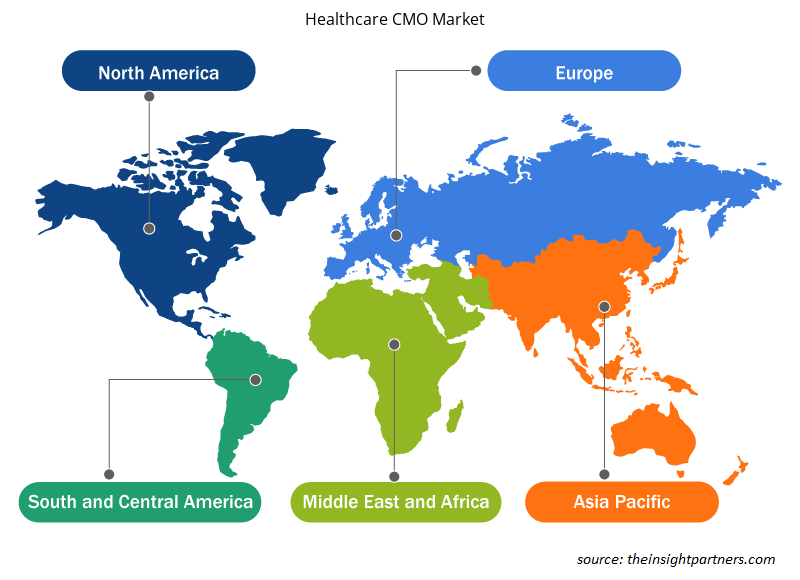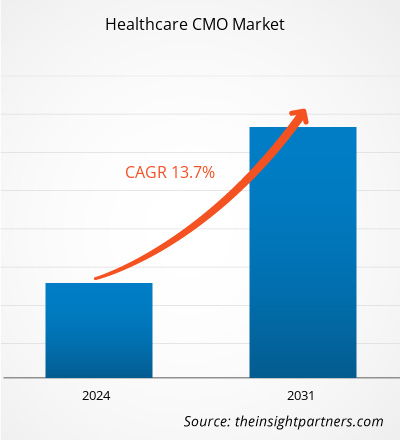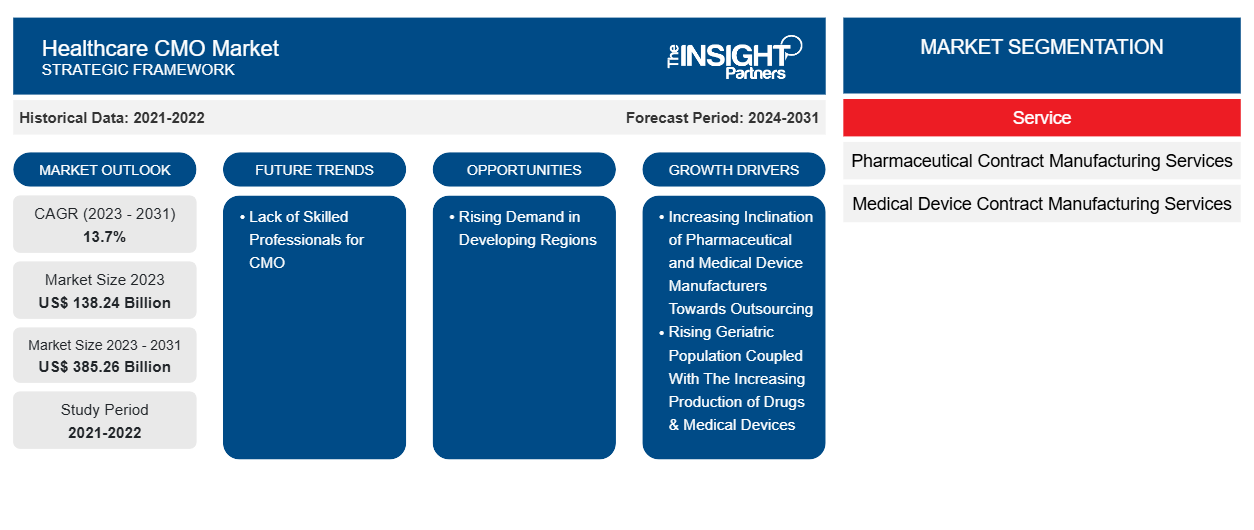Der Markt für CMOs im Gesundheitswesen wird voraussichtlich von 138,24 Milliarden US-Dollar im Jahr 2023 auf 385,26 Milliarden US-Dollar im Jahr 2031 anwachsen. Der Markt wird zwischen 2023 und 2031 voraussichtlich eine durchschnittliche jährliche Wachstumsrate von 13,7 % verzeichnen. Die zunehmende Marktkonsolidierung und die Zunahme von Fusionen und Übernahmen werden voraussichtlich weiterhin die wichtigsten Trends auf dem Markt bleiben.
CMO-Marktanalyse im Gesundheitswesen
Aufgrund der Fortschritte in der Biotechnologie und innovativer Therapien besteht eine wachsende Nachfrage nach Dienstleistungen von Auftragsherstellern (CMOs) für Biopharmazeutika und Biologika. Die Zunahme komplexer und spezialisierter Moleküle, darunter hochwirksame Arzneimittel und personalisierte Medikamente, hat die Nachfrage nach CMOs mit Fachkenntnissen in der Verwaltung komplexer Herstellungsprozesse erhöht. Der CMO-Markt im Gesundheitswesen wird zunehmend globaler, und Unternehmen suchen nach Partnerschaften mit CMOs in verschiedenen Regionen, um von Kosteneffizienzen, regulatorischen Vorteilen und Zugang zu unterschiedlichen Märkten zu profitieren.
Überblick über den CMO-Markt im Gesundheitswesen
CMOs bieten Dienstleistungen im Zusammenhang mit der Entwicklung, Herstellung und Verpackung von Arzneimitteln , Biotechnologieprodukten, Medizinprodukten und anderen Gesundheitsprodukten an. In der Gesundheitsbranche tendiert der Trend zum Outsourcing an CMOs. Unternehmen nutzen das Fachwissen und die Fähigkeiten von CMOs, um Herstellungsprozesse zu optimieren und sich auf Kernkompetenzen zu konzentrieren. CMOs, die flexible und skalierbare Fertigungslösungen anbieten, sind gefragt. Die Anpassung an unterschiedliche Produktionsgrößen und -pläne ist für Pharma- und Biotechunternehmen von entscheidender Bedeutung.
Passen Sie diesen Bericht Ihren Anforderungen an
Sie erhalten kostenlos individuelle Anpassungen an jedem Bericht, einschließlich Teilen dieses Berichts oder einer Analyse auf Länderebene, eines Excel-Datenpakets sowie tolle Angebote und Rabatte für Start-ups und Universitäten.
-
Holen Sie sich die wichtigsten Markttrends aus diesem Bericht.Dieses KOSTENLOSE Beispiel umfasst eine Datenanalyse von Markttrends bis hin zu Schätzungen und Prognosen.
Treiber und Chancen auf dem CMO-Markt im Gesundheitswesen
Steigende geriatrische Bevölkerung gepaart mit der zunehmenden Produktion von Medikamenten und medizinischen Geräten begünstigen den Markt
Die Zahl der geriatrischen Bevölkerung ist weltweit deutlich gestiegen. Laut den von den Vereinten Nationen veröffentlichten Daten wächst die geriatrische Bevölkerung schätzungsweise jedes Jahr um 3 %. Europa und der asiatisch-pazifische Raum haben die höchste Altersgruppe der über 60-Jährigen. Darüber hinaus wird die alternde Weltbevölkerung voraussichtlich von 1,4 Milliarden im Jahr 2030 auf 2,1 Milliarden im Jahr 2050 anwachsen. Die Alterung wird mit verschiedenen chronischen Krankheiten wie Herz-Kreislauf-Erkrankungen, Diabetes, Krebs und vielen anderen in Verbindung gebracht. Dadurch steigt die Nachfrage nach therapeutischen Produkten und medizinischen Geräten in diesen Altersgruppen. Daher wird erwartet, dass die oben genannten Faktoren den Markt für CMOs im Gesundheitswesen aufgrund der steigenden Nachfrage weltweit ankurbeln werden.
Wachstumschancen durch zunehmende Entwicklung von Biosimilars
Die Biosimilars werden immer attraktiver, da sich die Verbraucher offensichtlich Kosteneinsparungen erhoffen und sich für Hersteller alternativer Arzneimittel die Möglichkeit bietet, sowohl in etablierte als auch in aufstrebende Märkte einzutreten. Technologische Fortschritte und Verbesserungen beim Verständnis von Krankheiten wie Krebs, rheumatoider Arthritis und anderen führen zu einer erhöhten Nachfrage nach der Entwicklung von Biosimilars und Biologika. Um die unerfüllten Bedingungen zu erfüllen, investieren viele Unternehmen massiv in die Herstellung von Biologika, was im Gegenzug höhere Umsätze generieren würde. Die Schwellenländer wie China, Indien, Australien und Südkorea verfügen über die größten Biotechnologiezentren und erleben aufgrund der aufstrebenden Akteure ein Marktwachstum. Daher ziehen es die Unternehmen vor, die Herstellungsdienstleistungen an die CMOs auszulagern, um interne Kosten und Zeit für Testdienstleistungen während des Entwicklungsprozesses der Biologika und Biosimilars zu sparen. Diese Verschiebung hin zur Bevorzugung von CMOs gegenüber der internen Herstellung dürfte die Wachstumschancen der CMOs weltweit in den kommenden Jahren erhöhen.
Segmentierungsanalyse des CMO-Marktberichts im Gesundheitswesen
Wichtige Segmente, die zur Ableitung der CMO-Marktanalyse im Gesundheitswesen beigetragen haben, basieren auf Dienstleistungen.
- Basierend auf dem Service ist der CMO-Markt im Gesundheitswesen in pharmazeutische Auftragsfertigungsdienste und Auftragsfertigungsdienste für medizinische Geräte unterteilt. Die pharmazeutischen Auftragsfertigungsdienste werden weiter in aktive pharmazeutische Inhaltsstoffe (API), Herstellung der endgültigen Darreichungsform und Verpackung unterteilt. In ähnlicher Weise sind die Auftragsfertigungsdienste für medizinische Geräte in Outsourcing-Design, Geräteherstellung und Endmontage unterteilt. Das Segment der pharmazeutischen Auftragsfertigungsdienste hatte 2023 den größten Marktanteil und wird im Prognosezeitraum voraussichtlich die höchste durchschnittliche jährliche Wachstumsrate verzeichnen.
Marktanteilsanalyse für CMOs im Gesundheitswesen nach geografischer Lage
Der geografische Umfang des Berichts zum CMO-Markt im Gesundheitswesen ist hauptsächlich in fünf Regionen unterteilt: Nordamerika, Asien-Pazifik, Europa, Naher Osten und Afrika sowie Süd- und Mittelamerika.
Nordamerika dominiert den CMO-Markt im Gesundheitswesen. Das Wachstum des CMO-Marktes im Gesundheitswesen in Nordamerika ist auf die Zunahme der Pharma-, Biopharma- und Medizingerätebranche, günstige Bedingungen und eine gut regulierte Gesundheitsbranche zurückzuführen. Die USA hatten 2023 den größten Marktanteil. Die USA sind der größte Markt für die Pharma- und Biopharmaindustrie, das Land macht etwa ein Drittel des Weltmarkts aus. Die USA gelten als weltweit führend bei Forschungs- und Entwicklungsaktivitäten im Bereich Biopharmazie. Darüber hinaus fördert die Unterstützung durch die Regierung die Auftragsfertigung von Pharmazeutika und Biopharmazeutika. Dies trägt dazu bei, Unternehmen zur Entwicklung von Medikamenten, Gegenmaßnahmen und entsprechenden Diagnostika zu bewegen, die für die öffentliche Gesundheit und Sicherheit erforderlich sind. Darüber hinaus hat eine Zunahme der Herstellung komplexer Geräte Freiheit von den alltäglichen Sorgen verschafft und ermöglicht es, sich stärker auf die Kerntechnologie des Unternehmens zu konzentrieren und sich stärker darauf zu konzentrieren, was das Marktwachstum in der Region fördert.
Regionale Einblicke in den CMO-Markt im Gesundheitswesen
Die regionalen Trends und Faktoren, die den CMO-Markt im Gesundheitswesen während des Prognosezeitraums beeinflussen, wurden von den Analysten von Insight Partners ausführlich erläutert. In diesem Abschnitt werden auch die Marktsegmente und die Geografie des CMO-Marktes im Gesundheitswesen in Nordamerika, Europa, im asiatisch-pazifischen Raum, im Nahen Osten und Afrika sowie in Süd- und Mittelamerika erörtert.

- Erhalten Sie regionale Daten zum CMO-Markt im Gesundheitswesen
Umfang des CMO-Marktberichts im Gesundheitswesen
| Berichtsattribut | Details |
|---|---|
| Marktgröße im Jahr 2023 | 138,24 Milliarden US-Dollar |
| Marktgröße bis 2031 | 385,26 Milliarden US-Dollar |
| Globale CAGR (2023 - 2031) | 13,7 % |
| Historische Daten | 2021-2022 |
| Prognosezeitraum | 2024–2031 |
| Abgedeckte Segmente |
Nach Service
|
| Abgedeckte Regionen und Länder |
Nordamerika
|
| Marktführer und wichtige Unternehmensprofile |
|
Marktteilnehmerdichte: Der Einfluss auf die Geschäftsdynamik
Der Markt für CMOs im Gesundheitswesen wächst rasant. Dies wird durch die steigende Nachfrage der Endnutzer aufgrund von Faktoren wie sich entwickelnden Verbraucherpräferenzen, technologischen Fortschritten und einem größeren Bewusstsein für die Vorteile des Produkts vorangetrieben. Mit der steigenden Nachfrage erweitern Unternehmen ihr Angebot, entwickeln Innovationen, um die Bedürfnisse der Verbraucher zu erfüllen, und nutzen neue Trends, was das Marktwachstum weiter ankurbelt.
Die Marktteilnehmerdichte bezieht sich auf die Verteilung der Firmen oder Unternehmen, die in einem bestimmten Markt oder einer bestimmten Branche tätig sind. Sie gibt an, wie viele Wettbewerber (Marktteilnehmer) in einem bestimmten Marktraum im Verhältnis zu seiner Größe oder seinem gesamten Marktwert präsent sind.
Die wichtigsten auf dem CMO-Markt im Gesundheitswesen tätigen Unternehmen sind:
- Königliches DSM
- Catalent, Inc
- Boehringer Ingelheim International GmbH
- Recipharm AB (publ)
- Fareva
- Lonza
Haftungsausschluss : Die oben aufgeführten Unternehmen sind nicht in einer bestimmten Reihenfolge aufgeführt.

- Überblick über die wichtigsten Akteure auf dem Healthcare CMO-Markt
Neuigkeiten und aktuelle Entwicklungen zum CMO-Markt im Gesundheitswesen
Der CMO-Markt im Gesundheitswesen wird durch die Erhebung qualitativer und quantitativer Daten nach Primär- und Sekundärforschung bewertet, die wichtige Unternehmenspublikationen, Verbandsdaten und Datenbanken umfasst. Nachfolgend sind einige der Entwicklungen auf dem CMO-Markt im Gesundheitswesen aufgeführt:
- Kühne Holding AG hat eine endgültige Vereinbarung zur Übernahme der Pharma-Vertragsentwicklungs- und -herstellungsorganisation Aenova Group von der führenden internationalen Investmentfirma BC Partners geschlossen. Im Rahmen der Transaktion werden die von BC Partners beratenen Fonds neben der Kühne Holding AG reinvestieren und Aenova weiterhin als Minderheitsaktionär unterstützen. Finanzielle Bedingungen wurden nicht bekannt gegeben. Die Aenova Group ist eine der weltweit führenden CDMOs (Contract Development and Manufacturing Organizations) in der Pharma- und Gesundheitsbranche. (BC Partners, News, April 2024)
- Pharmascience, das größte kanadische Pharmaunternehmen, kündigte eine umfangreiche Erweiterung der Produktionsanlage für sterile Injektionspräparate im Wert von 120 Millionen US-Dollar an seinem Standort in Candiac an. Nach diesem wichtigen Meilenstein ist das Unternehmen nun stolz darauf, die Erweiterung seiner Auftragsentwicklungs- und Fertigungsorganisationsdienste (CDMO) mit der Schaffung einer neuen Geschäftseinheit für Injektionspräparate bekannt zu geben. (Pharmascience Inc., News, Februar 2024)
- Danaher Corporation gab eine endgültige Vereinbarung zur Übernahme des in Privatbesitz befindlichen Unternehmens Aldevron bekannt. Der Barkaufpreis beträgt rund 9,6 Milliarden US-Dollar. Danaher geht davon aus, die Übernahme mit Barmitteln und/oder durch die Ausgabe von Commercial Papers zu finanzieren. (Danaher Corporation, Pressemitteilung, Juni 2021)
Abdeckung und Ergebnisse des CMO-Marktberichts im Gesundheitswesen
Der Bericht „Marktgröße und Prognose für CMOs im Gesundheitswesen (2021–2031)“ bietet eine detaillierte Analyse des Marktes, die die folgenden Bereiche abdeckt:
- Größe und Prognose des CMO-Marktes im Gesundheitswesen auf globaler, regionaler und Länderebene für alle wichtigen Marktsegmente, die im Rahmen des Berichts abgedeckt sind
- Trends im Healthcare-CMO-Markt sowie Marktdynamiken wie Treiber, Einschränkungen und wichtige Chancen
- Detaillierte PEST- und SWOT-Analyse
- Analyse des CMO-Marktes im Gesundheitswesen, die wichtige Markttrends, globale und regionale Rahmenbedingungen, wichtige Akteure, Vorschriften und aktuelle Marktentwicklungen umfasst
- Branchenlandschaft und Wettbewerbsanalyse, einschließlich Marktkonzentration, Heatmap-Analyse, prominenten Akteuren und aktuellen Entwicklungen für den CMO-Markt im Gesundheitswesen
- Detaillierte Firmenprofile
- Historische Analyse (2 Jahre), Basisjahr, Prognose (7 Jahre) mit CAGR
- PEST- und SWOT-Analyse
- Marktgröße Wert/Volumen – Global, Regional, Land
- Branchen- und Wettbewerbslandschaft
- Excel-Datensatz
Aktuelle Berichte
Verwandte Berichte
Erfahrungsberichte
Grund zum Kauf
- Fundierte Entscheidungsfindung
- Marktdynamik verstehen
- Wettbewerbsanalyse
- Kundeneinblicke
- Marktprognosen
- Risikominimierung
- Strategische Planung
- Investitionsbegründung
- Identifizierung neuer Märkte
- Verbesserung von Marketingstrategien
- Steigerung der Betriebseffizienz
- Anpassung an regulatorische Trends























 Kostenlose Probe anfordern für - CMO-Markt im Gesundheitswesen
Kostenlose Probe anfordern für - CMO-Markt im Gesundheitswesen